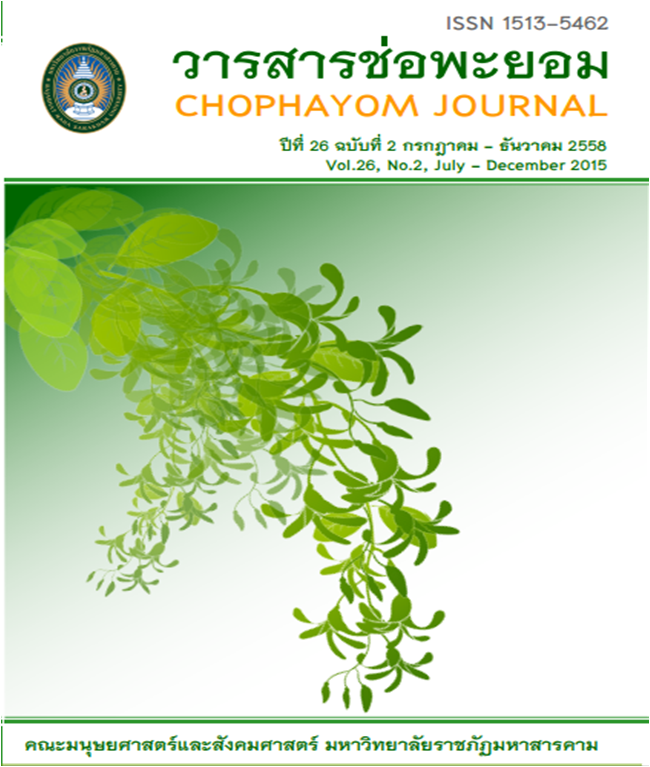รูปแบบการพัฒนาพฤติกรรมในการจัดการขยะมูลฝอยของนักเรียนระดับประถมศึกษา ชั้นปีที่ 4-6 สังกัดสำนักงานเขตพื้นที่การศึกษาประถมศึกษามหาสารคาม เขต 1-3 A Model for Behavioral Development of Garbage Disposal of 4-6th Grade Students in the Office ofMahaSarakham Pri
Abstract
บทคัดย่อ
การวิจัยเรื่อง รูปแบบการพัฒนาพฤติกรรมในการจัดการขยะมูลฝอยของนักเรียนระดับประถมศึกษาชั้นปีที่ 4-6 สังกัดสำนักงานเขตพื้นที่การศึกษาประถมศึกษามหาสารคาม เขต 1-3มีวัตถุประสงค์ 1) เพื่อศึกษาปัจจัยเชิงสาเหตุที่มีผลต่อพฤติกรรมในการจัดการขยะมูลฝอยของนักเรียนระดับประถมศึกษาชั้นปีที่ 4-6 สังกัดสำนักงานเขตพื้นที่การศึกษาประถมศึกษามหาสารคาม เขต 1-3 2) เพื่อสร้างรูปแบบการพัฒนาพฤติกรรมในการจัดการขยะมูลฝอยของนักเรียนระดับประถมศึกษาชั้นปีที่ 4-6 สังกัดสำนักงานเขตพื้นที่การศึกษาประถมศึกษามหาสารคาม เขต 1-3 3) เพื่อทดลองใช้และประเมินผลการใช้รูปแบบที่พัฒนาวิธีดำเนินการวิจัย แบ่งออกเป็น 3 ระยะ คือ ระยะที่ 1เป็นการวิจัยเชิงปริมาณ ประชากร คือ นักเรียนโรงเรียนประถมศึกษา สังกัดสำนักงานเขตพื้นที่การศึกษาประถมศึกษามหาสารคาม เขต 1-3 ปีการศึกษา 2556 กลุ่มตัวอย่างจำนวน 400 คน ได้มาโดยใช้วิธีการสุ่มแบบแบ่งชั้น (Stratified Random Sampling)การเก็บรวบรวมข้อมูลใช้แบบสอบถามและแบบทดสอบ ทดสอบสมมติฐานในการวิจัยใช้การวิเคราะห์เส้นทาง(Path Analysis) โดยใช้โปรแกรมลิสเรล (LISREL) ระยะที่ 2 การวิจัยเชิงคุณภาพ กลุ่มเป้าหมาย ได้แก่ ผู้ทรงคุณวุฒิ ผู้เชี่ยวชาญ นักวิชาการ และผู้เกี่ยวข้อง จำนวน 31 คน ใช้วิธีการเลือกแบบเจาะจง (Purposive sampling) วิธีดำเนินการวิจัยโดยการนำผลการวิจัยในระยะที่ 1 มายกร่างรูปแบบเบื้องต้น และจัดประชุมวิพากษ์รูปแบบ นำผลที่ได้มาปรับปรุงรูปแบบให้สมบูรณ์ ระยะที่ 3 การวิจัยเชิงทดลอง (Experimental Research) กลุ่มเป้าหมายคือ นักเรียนระดับประถมศึกษาชั้นปีที่ 4-6 โรงเรียนบ้านดอนสันติ สังกัดสำนักงานเขตพื้นที่การศึกษาประถมศึกษามหาสารคาม เขต 3 จำนวน 60 คน เก็บรวบรวมข้อมูลโดยใช้แบบสอบถามและแบบทดสอบ วิเคราะห์ข้อมูลทางสถิติโดยใช้โปรแกรมคอมพิวเตอร์ การทดสอบสมมติฐานการวิจัยใช้การวิเคราะห์ความแปรปรวนหลายตัวแปร ตามแบบวัดซ้ำ (Repeated Measures Multivariate Analysis of Variance : MANOVA) ผลการวิจัยปรากฏดังนี้
1. ปัจจัยด้านความรู้เกี่ยวกับขยะมูลฝอย ปัจจัยด้านความรู้เกี่ยวกับการจัดการขยะมูลฝอย
ปัจจัยด้านการสื่อสาร ปัจจัยด้านการมีส่วนร่วม และปัจจัยด้านการทำงานเป็นทีมมีผลต่อพฤติกรรมในการจัดการขยะมูลฝอยของนักเรียนระดับประถมศึกษาชั้นปีที่ 4-6 อย่างมีนัยสำคัญทางสถิติที่ระดับ .05
2. รูปแบบการพัฒนาพฤติกรรมในการจัดการขยะมูลฝอยของนักเรียนระดับประถมศึกษาชั้นปีที่ 4-6ประกอบด้วย การพัฒนาปัจจัยด้านความรู้เกี่ยวกับขยะมูลฝอย ปัจจัยด้านความรู้เกี่ยวกับการจัดการขยะมูลฝอย ปัจจัยด้านการสื่อสาร ปัจจัยด้านการมีส่วนร่วม และปัจจัยด้านการทำงานเป็นทีม รวม 11 กิจกรรม
3. นักเรียนระดับประถมศึกษาชั้นปีที่ 4-6 หลังการทดลองใช้รูปแบบการพัฒนาพฤติกรรมในการจัดการขยะมูลฝอยมีพฤติกรรมในการจัดการขยะมูลฝอยดีขึ้นกว่าเดิม
คำสำคัญ :รูปแบบการพัฒนา, พฤติกรรม, การจัดการขยะมูลฝอยของนักเรียน
ABSTRACT
The purposes of the research were to identify casual factors affecting the behaviors of garbage disposal of 4-6th grade students in the Office of MahaSarakham Primary Educational Service Area 1-3, to design a model for behavioral development of garbage disposal of the students, to implement and evaluate the model. The research methodology was divided into three phases. Phase 1 was the quantitative research. The samples were four hundred 4-6th grade students from primary schools in the Office of MahaSarakham Primary Educational Service Area 1-3 in 2013. Taro Yamane method was employed to calculate the sample size, and they were collected by stratified random sampling. The data were collected by a questionnaire and a test. Path analysis and LISREL were employed for data analysis. Phase 2 focused on the qualitative research. The target population was twenty eight participants consisting of experts, academicians and persons concerned with. They were selected by purposive random sampling. A model was criticized by experts, academicians and persons concerned with, and the model was assessed and developed for the implementation. Phase 3 focused on experimental research. The target population was sixty 4-6th grade students at Ban Don Santi Primary School in the Office of MahaSarakham Primary Educational Service Area 1-3. The data were collected by questionnaire and a test. MANOVA was employed for statistical analysis.
Results of the research were as follows:
- The finding indicated that five major factors positively affected the behaviors of garbage Disposal of the students at the .05 level of statistical significance. They were knowledge of garbage, garbage disposal, communication, participation, and team work skill.
- The research showed that the model for behavioral development of garbage disposal of the primary school students consisted of eleven activities, and the activities were used to develop five major factors: knowledge of garbage and garbage disposal, communication, participation and team work skill.
- The finding indicated that the behaviors of the students before and after using the model were different at the .05 level of statistical significance. In conclusion, the study indicates that the model positively affects the behaviors of garbage disposal of 4-6th grade students.






